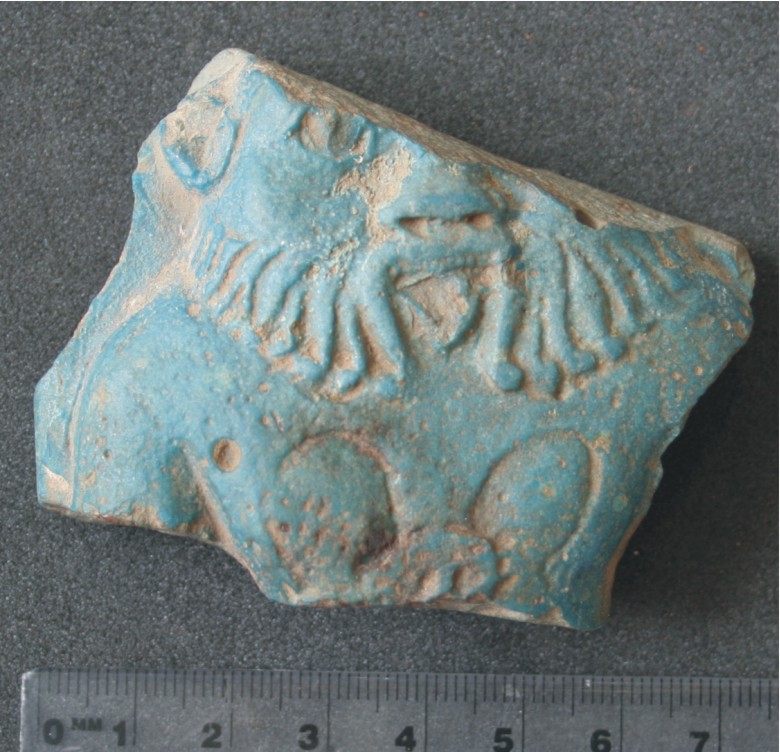EC257
EC257 Fragment of a Bes Vessel
 Blue faience fragment showing part of face of Bes. This is probably part of a faience vessel of the Late Period (c.600 BC). 7.5 x 2.3 x 5cm.
Blue faience fragment showing part of face of Bes. This is probably part of a faience vessel of the Late Period (c.600 BC). 7.5 x 2.3 x 5cm.
Bes is shown bearded and moustached with beard and moustache shown as long strands each ending in a tight curl. The mouth is open showing his teeth and sticking out tongue. He has a broad nose and flared nostrils. The head and feet of the leopard skin he wears are joined by two arcs.
The term ‘Bes’ is applied to a number of deities from the Middle Kingdom onwards. These deities tend to have leonine features and were connected with the sun-god. They also seem to have protected women and children, were often shown in conjunction with Taweret, Hathor and marshes, dancing and playing the hand-drum. Bes is often, as here, shown as a dwarf god, with a sticking out tongue and a leonine mane.
The flaring nostrils, wide head, teeth, whiskers shown as long individual strands each ending in a tight curls and leopard skin suggest a date of the Late Period (Romano 1980; Romano 1997 with references). According to Romano, faience Bes vessels similar to this in style date to the first few decades of the 26th Dynasty (670–600BC). Examples include Berlin 22200 (Schäfer and Andrae 1925, fig. 444(middle), 661–662). Not all examples were found in Egypt, for example Louvre AO25952 (Caubet 2010, 413, fig. 37.4a-e). Faience vessels possibly develop from earlier earthenware examples.
It is not clear what such vessels may have held. In the Graeco-Roman Period Bes is shown holding wine cups, or dancing with grapes. This might be because of his links with Greek satyrs. Additionally, from the Third Intermediate Period Bes was closely connected with Hathor and the celebrations surrounding the Return of the Distant Goddess, a celebration of the pacification of the goddess through alcohol. In the New Kingdom, blue painted ware, which it is sometimes assumed held wine for serving at festivals, though could have been used for other purposes, is sometimes decorated with applied heads of Bes. This might suggest that vessels such as these held wine.
Bes is also closely connected with water, through: his appearance on marsh scenes (in their turn possibly connected with Inundation Festivals and the Return of the Distant Goddess) from the Third Intermediate Period; his connection with Taweret from the New Kingdom; his incorporation in cippi objects over which water was poured and which ensure that the user has protection against dangerous creatures of the water; his occasional incorporation in Ptolemaic sha-basins, a type of ritual basin, such as British Museum 1885,1101.22.
They may alternatively have held perfumed oil, or even milk. Small examples are known to have held kohl, e.g. (Kozloff and Bryan 1992, 409) so to have larger examples holding perfumes seems possible).
References and further reading
For information on ceramic Bes vessels See Kaiser, R.K. 2003 ‘Water, Milk, Beer and Wine for the Living and the Dead: Egyptian and Syrio Palestinian Bes-Vessels from the New Kingdom through the Graeco Roman period’ unpublished PhD thesis, University of California.
Caubet, A. 2010. From Susa to Egypt. Vitreous materials from the Archaemenid Period, In Curtis, J. and Simpson, St.J. (eds.), The World of Achaemenid Persia: History, Art and Society in Iran and the Ancient Near East, London and New York: I.B. Tauris 409–416.
Dasen V. 1993. Dwarfs in ancient Egypt and Greece. New York: Oxford University Press, 55–83.
Kozloff, A.P. and Bryan, B.M. 1992. Egypt’s Dazzling Sun. Amenhotep III and his world. Cleveland: Cleveland Museum of Art.
Romano, J. 1980. ‘The Origin of the Bes-Image’. Bulletin of the Egyptological Seminar 2: 39-56.
Romano, J.F. 1989. The Bes-image in Pharaonic Egypt Unpublished PhD, New York University.
Romano, J.F. 1997. 18. Vessel in the form of a Bes-image. In Capel, A.K. and Markoe, G.E. (eds.) Mistress of the House, Mistress of Heaven. Women in Ancient Egypt, New York: Hudson Hills Press and Cincinnati Art Museum, 68-70, 196.
Schäfer, H. and Andrae, W. 1925. Die Kunst des alten Orients, Berlin: Propyläen.
Wahlberg, E-L. 2012. The Wine Jars Speak. A Text Study. Part of an MA thesis from Uppsala University, online version downloaded August 2015: http://uu.diva-portal.org/smash/get/diva2:528049/FULLTEXT01.pdf